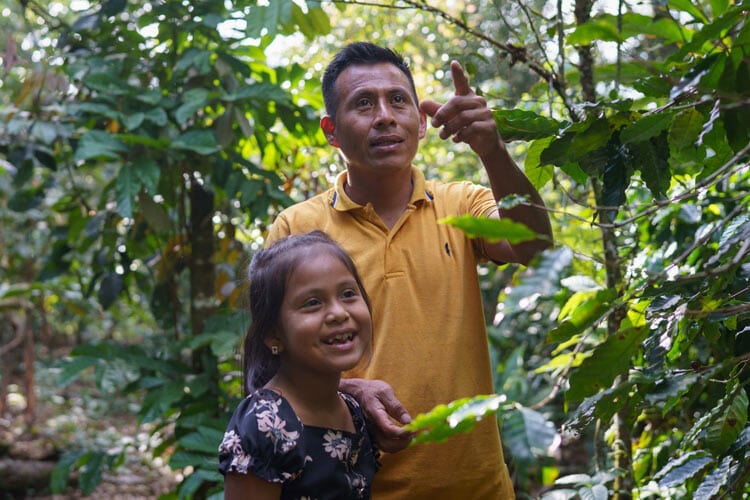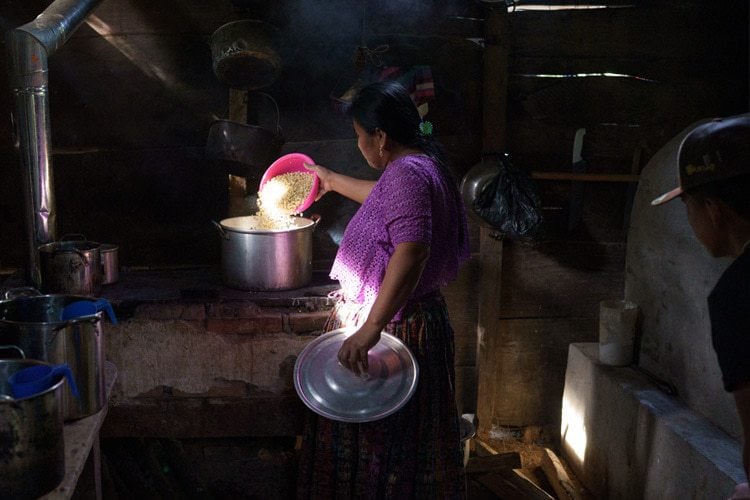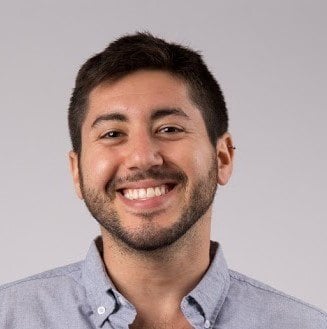Isabel Chen Ical and her husband, Agustín Chocooj, live with their two children and members of their extended family on a lush, fertile plot of land in Cerro Alto village, in rural Guatemala. They are members of the Q’eqchi Indigenous community — one of Guatemala’s 24 distinct ethnic groups.
There’s one family member she speaks of with particular admiration: ‘Qana’ch’och’,’ the name of Mother Earth in her native Q’eqchi language.
“When we say ‘Mother Earth,’ this is not just a concept. She is our mother — she gives us everything we need to survive,” says Isabel.
Agustín chimes in and says proudly, “We grow a wide variety of food to keep our family healthy: Corn and beans, of course, but also oranges, mandarins, lychees, cacao, papaya, coconut, lemons, pineapple, yuca, taro, cloves, cinnamon and coffee.”

Inside their home, Agustín’s mother is roasting cacao beans for an afternoon snack; an aunt is slicing the skin off a massive papaya; chickens and pigs lounge in the sun behind their house.
Life in Isabel and Agustín’s home seems, frankly, idyllic. But their family and community have survived generations of persecution and oppression from the government, the military and Guatemala’s ruling class of Spanish-descendent landowners.
And today, they face another existential threat: Guatemala’s National institute of Electrification (INDE) has announced plans to build a hydroelectric dam on the nearby Chixoy River that would flood the valley — and force Isabel, Agustín and 19,000 other Indigenous villagers to lose their homes. But AJWS grantee ACODET — the Association of Communities for the Development, Defense of Land and Natural Resources — has been fighting back.
ACODET is a grassroots coalition of 36 agricultural villages along the Chixoy and Copón rivers that has successfully fended off these government plans for years through tireless community organizing and education campaigns. Whenever INDE tries to launch construction, ACODET mobilizes villagers to flood government offices with complaints, petitions and a booming resistance. Thus far, they’ve been successful — protecting the land, water and way of life of these Indigenous communities.
In recent years, ACODET has expanded its scope, transforming the movement’s solidarity against the dam into a unified effort to keep their communities healthy, safe and thriving. Advocating for a return to organic farming and other eco-friendly initiatives are at the forefront of ACODET’s shift, and Agustín and Isabel lead by example.
“You can’t feed Mother Earth chemicals and expect that, in return, she’ll feed you healthy food,” says Agustín. “In all my years living on this land, I’ve never used chemical fertilizers. My family does not consume chemicals — our foods are 100% organic, and 100% healthy. Many of our neighbors who were farming with chemical pesticides and fertilizers are now switching back. Our Indigenous tradition demands it.”

Beyond a growing return to organic farming among the 36 communities, ACODET is also educating villagers how to cut out inorganic products in other areas — like creating fully organic soap and laundry detergent. What local people once saw as a quick convenience, they are increasingly viewing as an attack on their Indigenous values; plastics and chemicals getting in the way of their loving, reciprocal relationship with Qana’ch’och’.
“ACODET was born to face the threat of the dam,” says Agustín. “But from there, we had the idea to bring our focus to the wellness and permanence of our communities.”
While chemical products are an easy starting point, members of the ACODET movement realize that the true threat to their way of life is much bigger: capitalism itself. They see that threat in the government’s desire to build the hydroelectric dam and sell electricity to nearby nations; they see it in how Guatemala’s rich, landowning families consolidate wealth; they see it in how these industries try to buy up — or outright steal — Indigenous land to grow cash crops.
“The bottom line of capitalism in Guatemala is to make money and sell resources without caring about the lives of those who live in the land where those resources exist,” says Agustín. “But we are those people. We are also not some abstract concept. And we deserve to live with dignity.”

